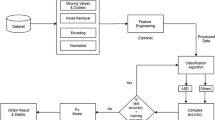Abstract
This paper represents our research to (i) propose an artificial intelligence, AI-based solution to identify depression and (ii) investigate our psychiatric knowledge. Concerning the first objective, we collected and annotated a new audio data set, and scrutinized the performance of eight regression approaches. Our studies showed that k-nearest neighbor and random forest form the group having the most acceptable results. Regarding our second objective, we determined the importance of the features of our best model using the SHapley Additive exPlanations approach: our findings showed that the fourth Mel-frequency cepstral coefficients, harmonic difference, and shimmer are the most important features.


Similar content being viewed by others
REFERENCES
Depressive disorder. https://www.who.int/news-room/fact-sheets/detail/depression
E. Strumbelj and I. Kononenko, “Explaining prediction models and individual predictions with feature contributions,” Knowl. Inf. Syst. 41 (3), 647–665 (2014)
F. Eyben, M. Wöllmer, and B. Schuller, “OpenSMILE: The Munich versatile and fast open-source audio feature extractor,” in Proceedings of the 18th ACM International Conference on Multimedia (ACM, New York, 2010), pp. 1459–1462.
F. Eyben, K. R. Scherer, B. W. Schuller, J. Sundberg, E. André, C. Busso, L. Y. Devillers, J. Epps, P. Laukka, S. S. Narayanan, et al., “The Geneva minimalistic acoustic parameter set (GeMAPS) for voice research and affective computing,” IEEE Trans. Affective Comput. 7 (2), 190–202 (2015).
J. Mockus, V. Tiešis, and A. Žilinskas, “The application of Bayesian methods for seeking the extremum,” in Towards Global Optimization (North-Holland, Amsterdam, 1978), pp. 117–129.
J. H. Friedman, “Greedy function approximation: A gradient boosting machine,” Ann. Stat. 29 (5), 1189–1232 2001).
J. L. Bentley, “Multidimensional binary search trees used for associative searching,” Commun. ACM 18 (9), 509–517 (1975).
L. Breiman, “Random forests,” Mach. Learn. 45 (1), 5–32 (2001).
M. Khudyakova, N. Antonova, M. Nelubina, A. Surova, A. Vorobyova, A. Minnigulova, N. Gronskaya, K. Yashin, I. Medyanik, T. Shishkovskaya, et al., “Discourse diversity database (3D) for clinical linguistics research: Design, development, and analysis,” Bakhtiniana Revista de Estudos do Discurso 18 (1), 32–57 (2023).
S. M. Lundberg and S. Lee, “A unified approach to interpreting model predictions,” in Advances in Neural Information Processing Systems, Ed. by I. Guyon, U. V. Luxburg, S. Bengio, H. Wallach, R. Fergus, S. Vishwanathan, and R. Garnett (Curran Associates, 2017), pp. 4765–4774.
K. P. Murphy, Probabilistic Machine Learning: An Introduction (MIT, Cambridge, Mass., 2022).
P. Wu, R. Wang, H. Lin, F. Zhang, J. Tu, and M. Sun, “Automatic depression recognition by intelligent speech signal processing: A systematic survey,” CAAI Transactions on Intelligence Technology (2022).
T. Hastie, S. Rosset, J. Zhu, and H. Zou, “Multi-class AdaBoost,” Stat. Interface 2 (3), 349–360 (2009).
Funding
This study was supported by the grant for research centers in the field of AI provided by the Analytical Center for the Government of the Russian Federation (ACRF) in accordance with the agreement on the provision of subsidies (identifier of the agreement 000000D730321P5Q0002) and the agreement with HSE University no. 70-2021-00139.
Author information
Authors and Affiliations
Contributions
Sh. S.: Conceptualization, Methodology, Investigation, Software, Validation, Formal analysis, Writing – original draft (WOD), Writing – review and editing. K. A.: Investigation, Software, Validation, WOD. Sh. T.: Data curation. Kh. M.: Conceptualization, Data curation, Writing – review and editing. D. O.: Conceptualization, Writing – review and editing, Resources, Project administration.
All authors read and approved the final manuscript.
Corresponding authors
Ethics declarations
The authors of this work declare that they have no conflicts of interest.
Additional information
Publisher’s Note.
Pleiades Publishing remains neutral with regard to jurisdictional claims in published maps and institutional affiliations.
Rights and permissions
About this article
Cite this article
Shalileh, S., Koptseva, A.O., Shishkovskaya, T.I. et al. An Explained Artificial Intelligence-Based Solution to Identify Depression Severity Symptoms Using Acoustic Features. Dokl. Math. 108 (Suppl 2), S374–S381 (2023). https://doi.org/10.1134/S1064562423701090
Received:
Revised:
Accepted:
Published:
Issue Date:
DOI: https://doi.org/10.1134/S1064562423701090




